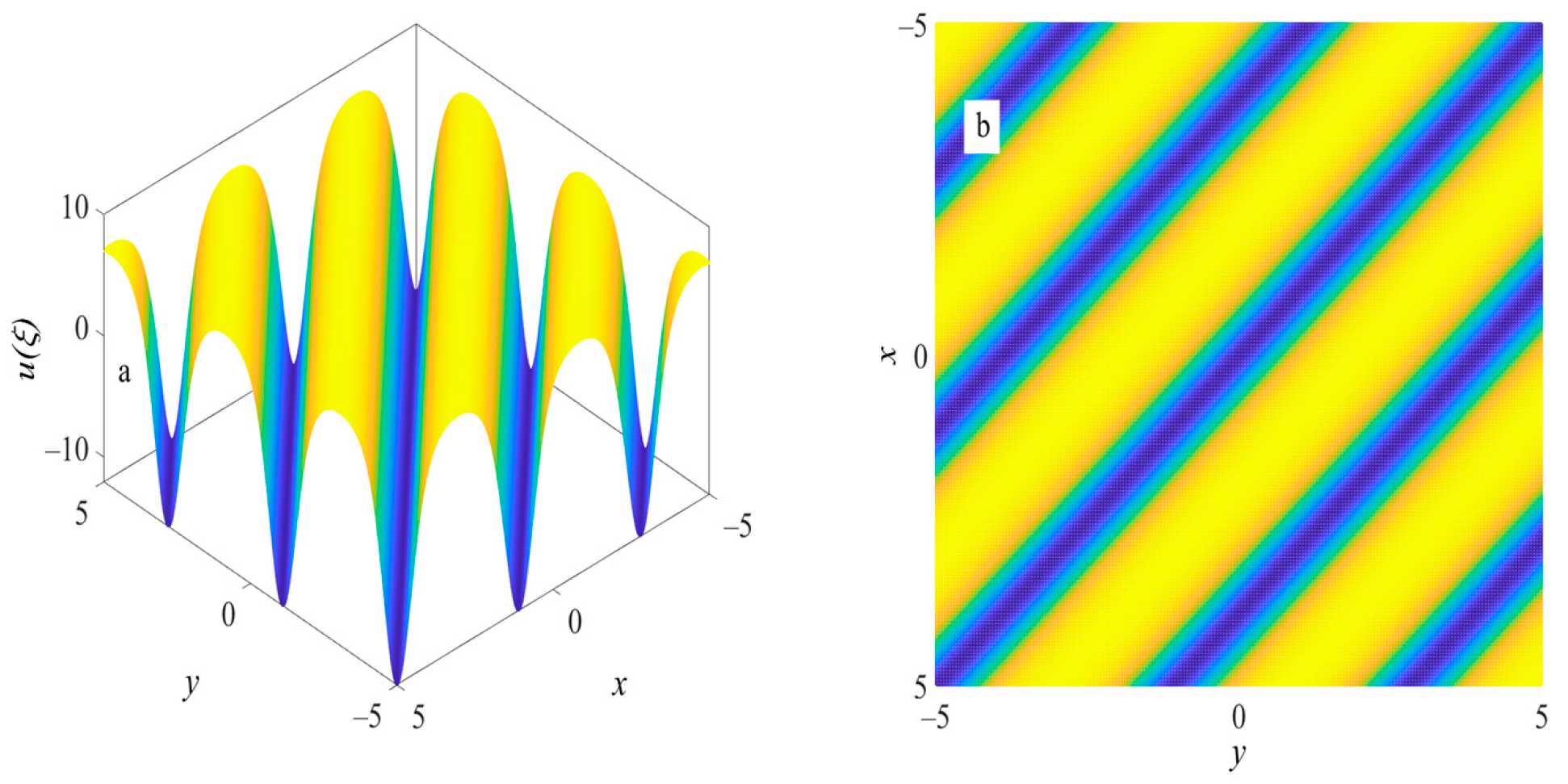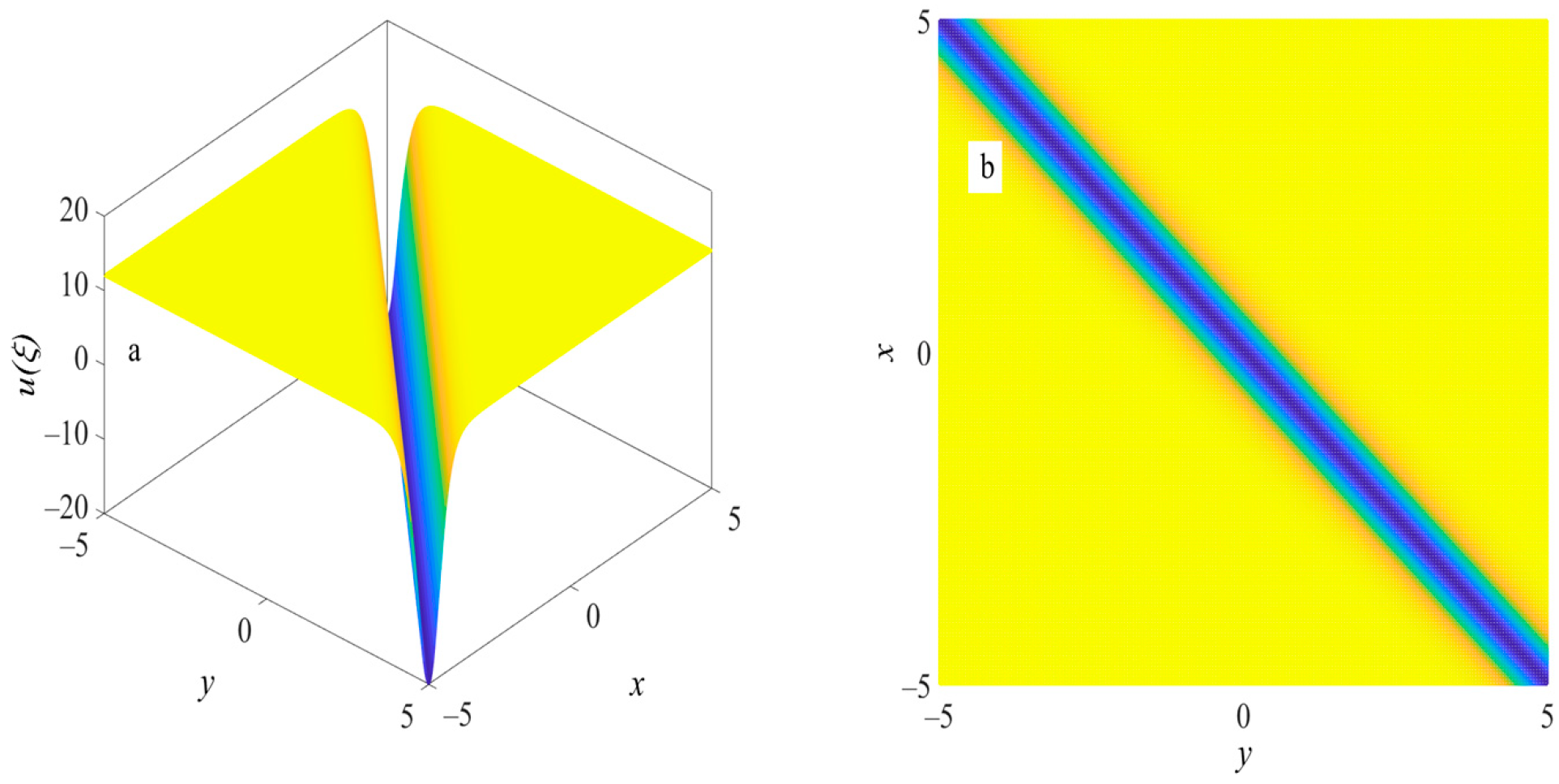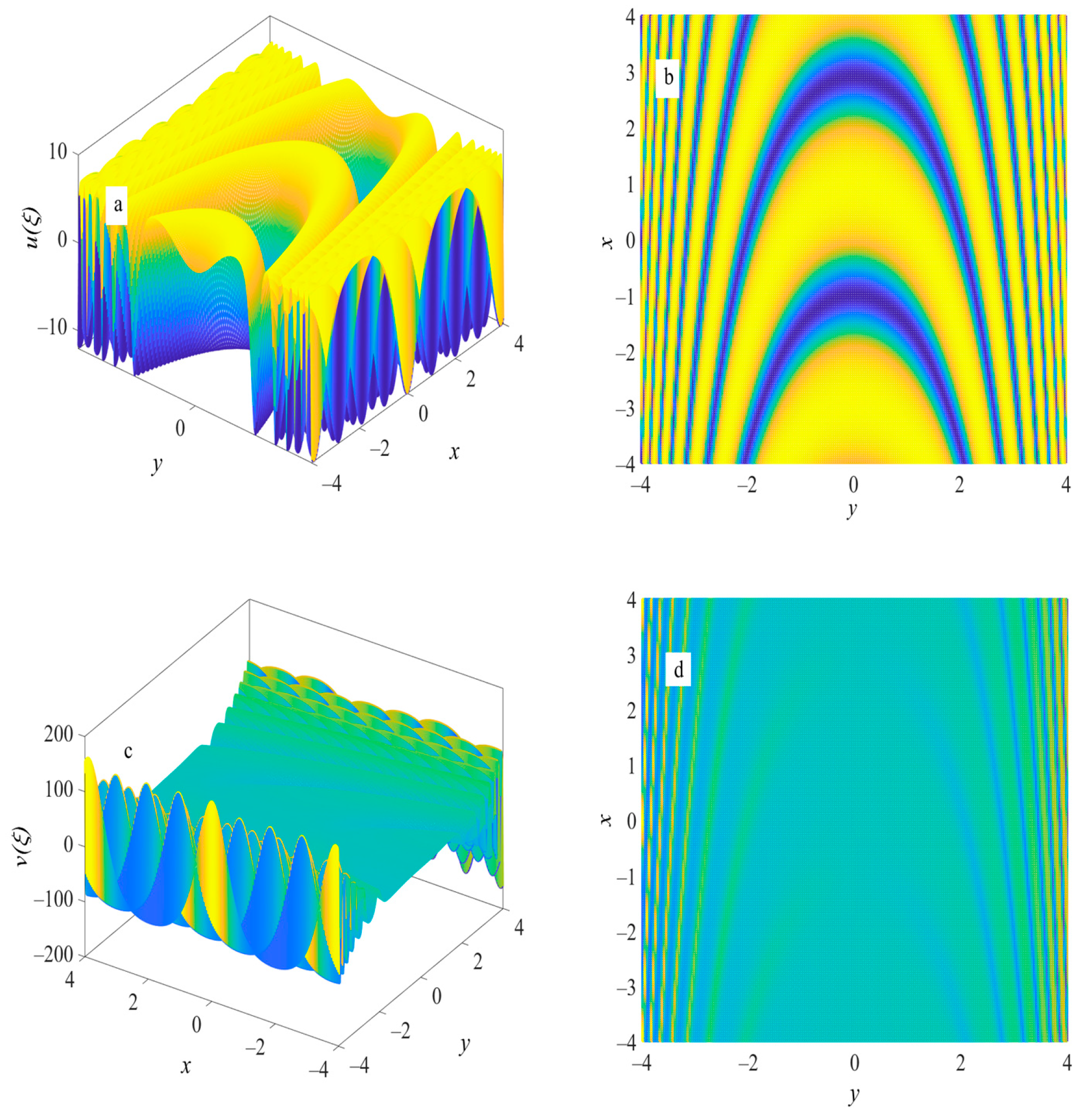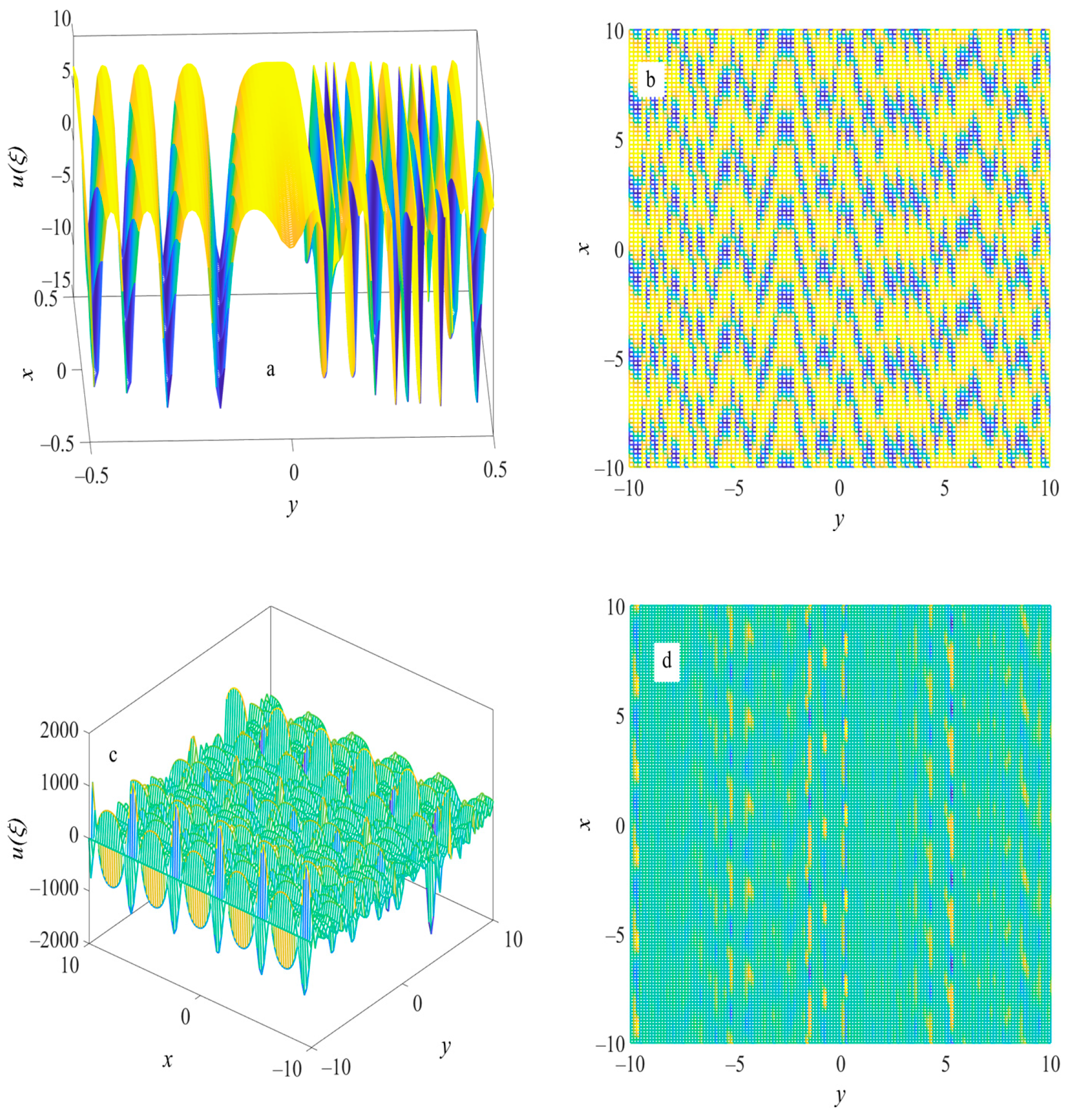New Complex Wave Solutions and Diverse Wave Structures of the (2+1)-Dimensional Asymmetric Nizhnik–Novikov–Veselov Equation
Abstract
:1. Introduction
2. Solutions of Elliptic Jacobian Equation
3. Method and Application to the (2+1)-Dimensional aNNV Equation
4. Demonstration of the Solutions
5. Local Wave Structures of (2+1)-Dimensional aNNV System
5.1. Periodic Wave Structure and Solitary Wave Structure
5.2. Complex Wave Structure
5.3. Chaotic Wave Structure
5.4. Spiral Wave Structure
6. Conclusions and Discussion
Author Contributions
Funding
Institutional Review Board Statement
Informed Consent Statement
Data Availability Statement
Acknowledgments
Conflicts of Interest
References
- Guo, H.-D.; Xia, T.-C.; Hu, B.-B. High-order lumps, high-order breathers and hybrid solutions for an extended (3+1)-dimensional Jimbo-Miwa equation in fluid dynamics. Nonlinear Dyn. 2020, 100, 601. [Google Scholar] [CrossRef]
- Lan, Z.-Z.; Guo, B.-L. Nonlinear waves behaviors for a coupled generalized nonlinear Schrodinger-Boussinesq system in a hom generous magnetized plasma. Nonlinear Dyn. 2020, 100, 3771. [Google Scholar] [CrossRef]
- Biswas, A.; Ekici, M.; Sonmezoglu, A.; Belic, M.R. Solitons in optical fiber Bragg gratings with dispersive reflectivity by extended trial function method. Optik 2019, 182, 88. [Google Scholar] [CrossRef]
- Seadawy, A.R.; Lu, D.; Nasreen, N.; Nasreen, S. Structure of optical solitons of resonant Schrodinger equation with quadratic cubic nonlinearity and modulation instability analysis. Phys. A Stat. Mech. Its Appl. 2019, 534, 122155. [Google Scholar] [CrossRef]
- Abdoud, M.A.; Owyed, S.; Abdel-Aty, A.; Raffan, B.M.; Abdel-Khalek, S. Optical soliton solutions for a space-time fractional perturbed nonlinear Schrödinger equation arising in quantum physics. Results Phys. 2020, 16, 102895. [Google Scholar] [CrossRef]
- Peng, W.-Q.; Tian, S.-F.; Zhang, T.-T. Dynamics of the soliton waves, breather waves, and rogue waves to the cylindrical Kadomtsev-Petviashvili equation in pair-ion-electron plasma. Phys. Fluids 2019, 31, 102107. [Google Scholar] [CrossRef]
- Wazwaz, A.-M. The extended tanh method for new compact and noncompact solutions for the KP–BBM and the ZK–BBM equations. Chaos Solitons Fractals 2008, 38, 1505. [Google Scholar] [CrossRef]
- Yusofoǧlu, E. New solitonary solutions for the MBBM equations using Exp-function method. Phys. Lett. A 2008, 372, 442. [Google Scholar] [CrossRef]
- Gardner, C.S.; Greene, J.M.; Kruskal, M.D.; Miura, R.M. Method for solving Korteweg-de Vries equation. Phys. Rev. Lett. 1967, 19, 1095. [Google Scholar] [CrossRef]
- Su, C.H.; Gardner, C.S. Korteweg-de Vries Equation and Generalizations. III. Derivation of the Korteweg-de Vries Equation and Burgers Equation. J. Math. Phys. 1969, 10, 536. [Google Scholar] [CrossRef]
- Li, Z.B.; Wang, M.L. Travelling wave solutions to the two-dimensional KdV-Burgers equation. J. Phy. A: Math. Gen. 1993, 26, 6027. [Google Scholar] [CrossRef]
- Ito, M. An Extension of Nonlinear Evolution Equations of the K-dV (mK-dV) Type to Higher Orders. J. Phys. Soc. Jpn. 1980, 49, 771. [Google Scholar] [CrossRef]
- Wang, M. Solitary wave solutions for variant Boussinesq equations. Phys. Lett. A 1995, 199, 169. [Google Scholar] [CrossRef]
- Yan, C. A simple transformation for nonlinear waves. Phys. Lett. A 1996, 224, 77. [Google Scholar] [CrossRef]
- Arshad, M.; Seadawy, A.R.; Lu, D.; Wang, J. Travelling wave solutions of Drinfel'd-Sokolov-Wilson, Whitham-Broer-Kaup and (2+1)-dimensional Broer-Kaup-Kupershmit equations and their applications. Chin. J. Phys. 2017, 55, 780. [Google Scholar] [CrossRef]
- Seadawy, A.R. Stability analysis solutions for nonlinear three-dimensional modified Korteweg-de Vries-Zakharov-Kuznetsov equation in a magnetized electron-positron plasma. Phys. A Stat. Mech. Its Appl. 2016, 455, 44. [Google Scholar] [CrossRef]
- Liu, J.; Yang, K. The extended F-expansion method and exact solutions of nonlinear PDEs. Chaos Solitons Fractals 2004, 22, 111. [Google Scholar] [CrossRef]
- Zhang, S. Application of Exp-function method to a KdV equation with variable coefficients. Phys. Lett. A 2007, 365, 448. [Google Scholar] [CrossRef]
- Seadawy, A.R. Stability analysis for Zakharov-Kuznetsov equation of weakly nonlinear ion-acoustic waves in a plasma. Comput. Math. Appl. 2014, 67, 172. [Google Scholar] [CrossRef]
- Seadawy, A.R. Stability analysis for two-dimensional ion-acoustic waves in quantum plasmas. Phys. Plasmas 2014, 21, 052107. [Google Scholar] [CrossRef]
- Shek, E.C.M.; Chow, K.W. The discrete modified Korteweg-de Vries equation with non-vanishing boundary conditions: Interactions of solitons. Chaos Solitons Fractals 2008, 36, 296. [Google Scholar] [CrossRef]
- Liu, S.; Fu, Z.; Liu, S.; Zhao, Q. Jacobi elliptic function expansion method and periodic wave solutions of nonlinear wave equations. Phys. Lett. A 2001, 289, 69. [Google Scholar] [CrossRef]
- Boateng, K.; Yang, W.; Yaro, D.; Otoo, M.E. Jacobi Elliptic Function Solutions and Traveling Wave Solutions of the (2+1)-Dimensional Gardner-KP Equation. Math. Methods Appl. Sci. 2020, 43, 3457. [Google Scholar] [CrossRef]
- Li, H.-M. Searching for the (3+1)-dimensional Painleve integrable model and its solitary wave solution. Chin. Phys. Lett. 2002, 19, 745. [Google Scholar]
- Yomba, E. On exact solutions of the coupled Klein-Gordon-Schrodinger and the complex coupled KdV equations using mapping method. Chaos Solitons Fractals 2004, 21, 209. [Google Scholar] [CrossRef]
- Li, H. -M. New exact solutions of nonlinear Gross-Pitaevskii equation with weak bias magnetic and time-dependent laser fields. Chin. Phys. 2005, 14, 251. [Google Scholar] [CrossRef]
- Wu, G.; Han, J.; Zhang, W.; Zhang, M. New periodic wave solutions to nonlinear evolution equations by the extended mapping method. Phys. D-Nonlinear Phenom. 2007, 229, 116. [Google Scholar] [CrossRef]
- Zhu, X.; Cheng, J.; Chen, Z.; Wu, G. New Solitary-Wave Solutions of the Van der Waals Normal Form for Granular Materials via New Auxiliary Equation Method. Mathematics 2022, 10, 2560. [Google Scholar] [CrossRef]
- Tariq, K.U.-H.; Seadawy, A.R. Bistable Bright-Dark solitary wave solutions of the (3 + 1)-dimensional Breaking soliton, Boussinesq equation with dual dispersion and modified Korteweg–de Vries–Kadomtsev–Petviashvili equations and their applications. Results Phys. 2017, 7, 1143. [Google Scholar] [CrossRef]
- Clarkson, P.A.; Mansfield, E.L. Symmetry reductions and exact solutions of shallow water wave equations. Acta Appl. Math. 1995, 39, 245. [Google Scholar] [CrossRef]
- Boiti, M.; Leon, J.J.-P.; Manna, M.; Pempinelli, F. On the spectral transrorm of a Korteweg-de Vries equation in two spatial dimensions. Inverse Probl. 1986, 2, 271. [Google Scholar] [CrossRef]
- Tang, X.-Y.; Lou, S.-Y. A Variable Separation Approach to Solve the Integrable and Nonintegrable Models: Coherent Structures of the (2+1)-Dimensional KdV Equation. Commun. Theor. Phys. 2002, 38, 1. [Google Scholar] [CrossRef]
- Lou, S.-Y.; Ruan, H.-Y. Revisitation of the localized excitations of the (2+1)-dimensional KdV equation. J. Phys. A: Math. Gen. 2001, 34, 305. [Google Scholar] [CrossRef]
- Liu, J.-G.; Du, J.-Q.; Zeng, Z.-F.; Ai, G.-P. Exact periodic cross-kink wave solutions for the new (2+1)-dimensional KdV equation in fluid flows and plasma physics. Chaos 2016, 26, 103114. [Google Scholar] [CrossRef] [PubMed]
- Hossen, M.B.; Roshid, H.-O.; Ali, M.Z. Multi-soliton, breathers, lumps and interaction solution to the (2+1)-dimensional asymmetric Nizhnik-Novikov-Veselov equation. Heliyon 2019, 5, e02548. [Google Scholar] [CrossRef]
- Zhang, S.; Xia, T. An improved generalized F-expansion method and its application to the (2 + 1)-dimensional KdV equations. Commun. Nonlinear Sci. Numer. Simul. 2008, 13, 1294. [Google Scholar] [CrossRef]
- Elbrolosy, M.E.; Elmandouh, A.A. Bifurcation and new traveling wave solutions for (2 + 1)-dimensional nonlinear Nizhnik–Novikov–Veselov dynamical equation. Eur. Phys. J. Plus 2020, 135, 533. [Google Scholar] [CrossRef]
- Mohammed, W.W.; El-Morshedyb, M. The influence of multiplicative noise on the stochastic exact solutions of the Nizhnik–Novikov–Veselov system. Math. Comput. Simul. 2021, 190, 192. [Google Scholar] [CrossRef]
- Lorenz, E.N. Deterministic Nonperiodic Flow. J. Atmos. Sci. 1963, 20, 130. [Google Scholar] [CrossRef]








Disclaimer/Publisher’s Note: The statements, opinions and data contained in all publications are solely those of the individual author(s) and contributor(s) and not of MDPI and/or the editor(s). MDPI and/or the editor(s) disclaim responsibility for any injury to people or property resulting from any ideas, methods, instructions or products referred to in the content. |
© 2023 by the authors. Licensee MDPI, Basel, Switzerland. This article is an open access article distributed under the terms and conditions of the Creative Commons Attribution (CC BY) license (https://creativecommons.org/licenses/by/4.0/).
Share and Cite
Wu, G.; Guo, Y. New Complex Wave Solutions and Diverse Wave Structures of the (2+1)-Dimensional Asymmetric Nizhnik–Novikov–Veselov Equation. Fractal Fract. 2023, 7, 170. https://doi.org/10.3390/fractalfract7020170
Wu G, Guo Y. New Complex Wave Solutions and Diverse Wave Structures of the (2+1)-Dimensional Asymmetric Nizhnik–Novikov–Veselov Equation. Fractal and Fractional. 2023; 7(2):170. https://doi.org/10.3390/fractalfract7020170
Chicago/Turabian StyleWu, Guojiang, and Yong Guo. 2023. "New Complex Wave Solutions and Diverse Wave Structures of the (2+1)-Dimensional Asymmetric Nizhnik–Novikov–Veselov Equation" Fractal and Fractional 7, no. 2: 170. https://doi.org/10.3390/fractalfract7020170
APA StyleWu, G., & Guo, Y. (2023). New Complex Wave Solutions and Diverse Wave Structures of the (2+1)-Dimensional Asymmetric Nizhnik–Novikov–Veselov Equation. Fractal and Fractional, 7(2), 170. https://doi.org/10.3390/fractalfract7020170






